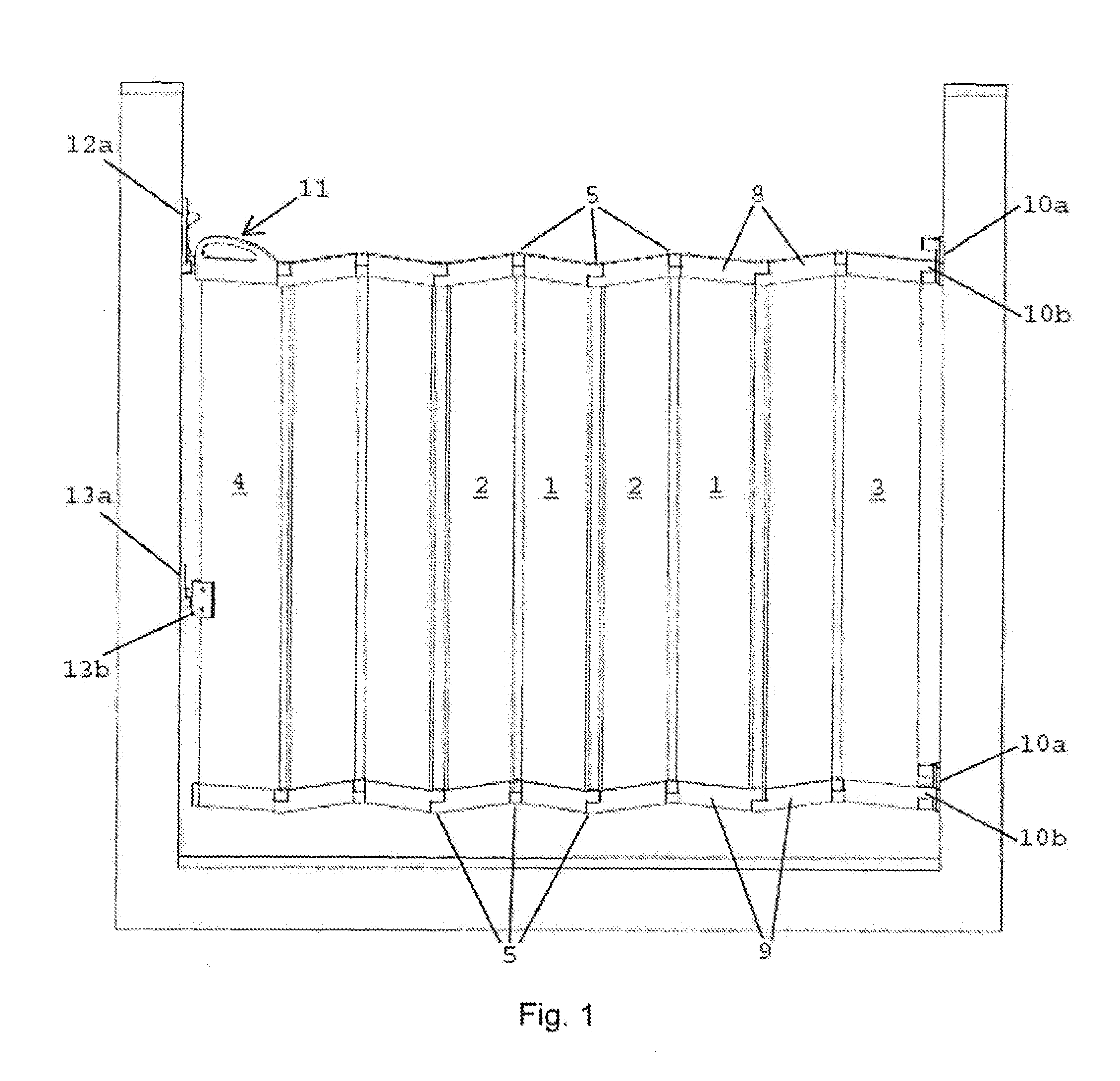Child Safety Gate
a child safety and gate technology, applied in the field of child safety gates, can solve the problems of not being useful around narrow openings or openings with a minimum of space, not being able to accommodate skirting boards, floor mouldings, etc., and not being able to meet the needs of children,
- Summary
- Abstract
- Description
- Claims
- Application Information
AI Technical Summary
Benefits of technology
Problems solved by technology
Method used
Image
Examples
first embodiment
[0039]FIG. 1 shows the invention mounted on a door frame in a closed position. FIG. 2 shows the invention shown in FIG. 1 in an open position. The invention comprises a child safety gate comprising one or more panels 1, 2, 3, 4, which may be mutual with each other, and which may be mounted in an opening, such as a door opening, a staircase opening, a corridor or passage, an entrance or the like. At least one hinge 5 may be disposed between each of the panels 1, 2, 3, 4, which hinge may be connected with the panel on both sides of the hinge, whereby the panels 1, 2, 3, 4 may be moved relative to each other. The child safety gate comprises two end panels 3, 4 disposed at their respective sides of the gate and a plurality of intermediate panels 1, 2, as shown in FIG. 1. The end panel 3 may be connected with at least one fitting 10, which may be secured to the opening, such as a wall or a frame. The end panel 4 may be connected with at least one closure device 12, 13 and an optional han...
second embodiment
[0040]The panel 1, 2, 3, 4 may have a solid or hollow structure and have a quadangular, elliptic, circular or any other polygonal or round cross-section. In a second embodiment, the panel structure may comprise two or more panel parts 6, 7, which may be secured to each other by means of friction or fasteners, such as screws, bolts or glue, as shown in FIG. 3. The panel parts 6, 7 may comprise one or more male parts and / or one or more female parts disposed opposite each other, e.g. on the inner side of their respective panel parts. The male part and the female part may be constructed as a pin joint comprising a pin and a pin hole, respectively. The pin joint may comprise a head or an elevation and a corresponding depression or groove, so that the male part and the female part are snapped together. The width and / or the height of the individual panels 1, 2, 3, 4 and the panel parts 6, 7 may be varied, thereby making it possible to adapt the number of panels in the child safety gate to ...
third embodiment
[0051]FIG. 7 shows a cross section of a third embodiment, where the hinge 5 may be embedded in the panels 1, 2, 3, 4. The hinge 5 may be constructed as a rotating hinge 16 comprising a first hinge part 16a and a second hinge part 16b capable of rotating about the first part 16a. The hinge parts 16a, 16b may be connected with their respective panels 1, 2, 3, 4. FIG. 7 shows the hinge parts 16a, 16b connected with their respective ends of an intermediate panel 1, 2. The second hinge part 16b may be constructed as a hollow or solid ball comprising an outer surface 17 and optionally an inner surface 18. Alternatively, the second hinge part 16b may be constructed as a hollow or solid cylinder. The first hinge part 16a may be constructed as a ball or cylinder section 19, which may be conformed to the second hinge part 16b. The hinge parts 16a, 16b may be interconnected so that the first hinge part 16a is capable of rotating about a central axis in the second hinge part 16b along the outer...
PUM
 Login to View More
Login to View More Abstract
Description
Claims
Application Information
 Login to View More
Login to View More - R&D
- Intellectual Property
- Life Sciences
- Materials
- Tech Scout
- Unparalleled Data Quality
- Higher Quality Content
- 60% Fewer Hallucinations
Browse by: Latest US Patents, China's latest patents, Technical Efficacy Thesaurus, Application Domain, Technology Topic, Popular Technical Reports.
© 2025 PatSnap. All rights reserved.Legal|Privacy policy|Modern Slavery Act Transparency Statement|Sitemap|About US| Contact US: help@patsnap.com



